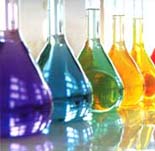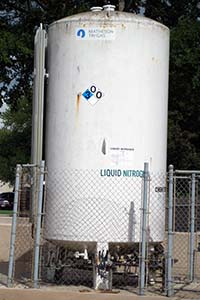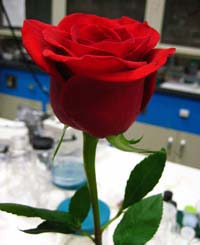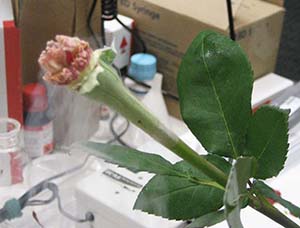Introduction
|
Nitrogen, in its elemental state, is a colorless, odorless diatomic gas which makes up approximately 80% of Earth’s atmosphere.
Cooling nitrogen gas below its boiling point of 77 Kelvin (-196 °C, -321 °F) causes it to condense into liquid nitrogen (commonly abbreviated LN2). Liquid nitrogen is a clear liquid which rapidly boils back into its gaseous form at room temperature unless stored in special containers, such as a Dewar flask, to minimize heat flow into the fluid from the surrounding environment. Liquid nitrogen is relatively inexpensive (~$0.25 per Liter, depending on the source) and used in a wide variety of settings and applications such as in hospitals, universities, and industrial manufacturing.
Freezing A Rose
 As
liquid nitrogen boils its temperature remains constant since
the thermal energy absorbed from the environment goes into
overcoming the latent heat of vaporization instead of
increasing the temperature of the LN2. Thus, liquid
nitrogen can be used as a coolant to lower the temperature of
objects down to the boiling point of nitrogen. At such low
temperatures the elastic properties of materials change;
objects which are flexible and resilient at room temperature
may become hard or even brittle at such low temperatures. One
such object which becomes extremely brittle is a rose.
As
liquid nitrogen boils its temperature remains constant since
the thermal energy absorbed from the environment goes into
overcoming the latent heat of vaporization instead of
increasing the temperature of the LN2. Thus, liquid
nitrogen can be used as a coolant to lower the temperature of
objects down to the boiling point of nitrogen. At such low
temperatures the elastic properties of materials change;
objects which are flexible and resilient at room temperature
may become hard or even brittle at such low temperatures. One
such object which becomes extremely brittle is a rose.
Freezing a rose in liquid nitrogen is a classic demonstration which illustrates how the elastic properties change at very low temperatures. In this demonstration an ordinary rose is immersed in liquid nitrogen for several seconds. After its temperature has dropped to near that of the boiling nitrogen, the rose is removed from the LN2 and then swiftly struck against a hard surface. A rose at room temperature would normally be able to survive such a blow, perhaps loosing a few pedals in the process but overall not suffering too much damage. The LN2-frozen rose, however, behaves considerably different. When the frozen rose is struck against the hard surface it shatters into numerous pieces, much like a piece of glass.
The drastically different behavior between the room temperature and LN2-frozen rose is due to formation of many tiny ice crystals inside the rose. The extremely cold temperature of the LN2 quickly freezes the water contained within the rose into ice and, as a result, the once-pliable rose becomes very brittle. Striking the rose against a hard surface causes the rose to break just like a piece of glass.
In the video, and accompanying pictures, below a rose is immersed into a container filled with liquid nitrogen for about 1 minute, which is more than enough time to thoroughly freeze the rose into a very brittle state. The rose is then struck against the edge of the table, shattering it into dozens of pieces and making a sound reminiscent of a piece of glass breaking. The pedal fragments remain brittle for several seconds afterward until they eventually warm back up to room temperature and become flexible again.
|
Video
|
|---|
Other Demonstrations
The cryogenic properties of LN2 have other amusing applications as well.
The boiling point of nitrogen (77 K) is significantly below the sublimation point of carbon dioxide (195 K). As such, liquid nitrogen can be used to make solid carbon dioxide, otherwise commonly known as 'Dry Ice'. Placing a balloon filled with CO2 gas into liquid nitrogen will first cause the gas inside the balloon to contract and the balloon will appear to deflate, just as predicted by Charles' Law. As the gas is cooled further it will begin to solidify, eventually producing dry ice inside the balloon.
Another popular demonstration involves using liquid nitrogen to make ice cream. After mixing the proper ingredients to make the ice cream, LN2 is added to cool and freeze the mixture. In the process the LN2 boils off into harmless Nitrogen gas, leaving behind solid ice cream which is safe to eat.
Last updated: 09/05/2008







